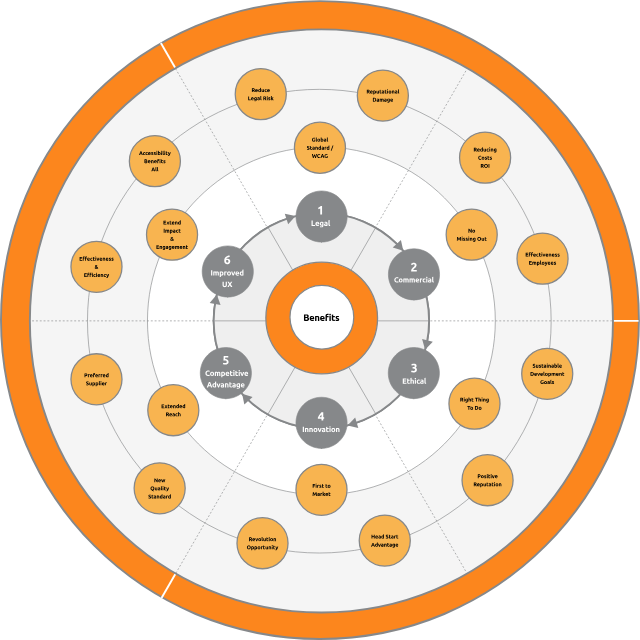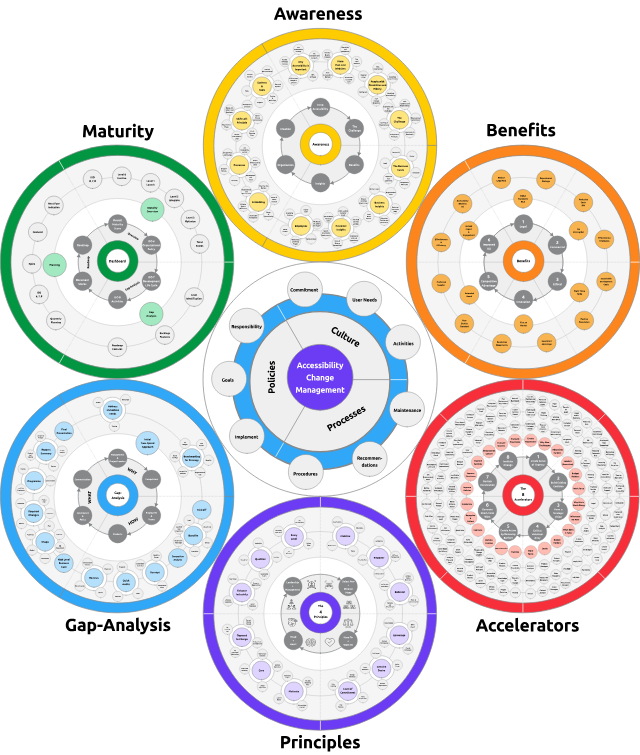
Awareness of the key business cases for accessibility, how they benefit organizations, and how they provide improved return on investment is a game changer for becoming more inclusive.
But in what way does it impact your organization? What insights do you need to gain? Who and how should employees be involved, and should communication be changed?
Once you have a deep understanding of the benefits and possibilities that products provide, the process of addressing feelings of being overwhelmed and initiating organizational change will flow more easily (with some assistance). It will become apparent what opportunities and obstacles lie ahead, as well as what issues need to be addressed.
This provides a clear WHY for accessibility and inclusivity, and together with a Gap-Analysis (the HOW) decide the WHAT to embed all successfully and become more inclusive step-by-step.
What are the organizational opportunities?
Underlining the key business cases of accessibility benefits:
- Sets a strong foundation for understanding organizational impact and importance.
- Underscores the tangible organizational advantage, prioritizing integrity and customer satisfaction.
- Strategic edge gained through forward-thinking initiatives and market differentiation.
Is Accessibility relevant for my organization?

Accessibility is important for all types of organizations, not just consumer sites or the public sector.
Emphasizing the importance of value and possibilities, benefits encompass anything that aids in progressing towards seizing opportunities.
A multitude of statements apply to all kinds of different organizations. Which ones are applicable to your organization?
Regardless of the type of organization or size, benefits make accessibility relevant in all of the following cases.
Does your organization:
- Has an external website or internal web-based applications?
- Creates websites, mobile apps?
- Employs other companies to build products and services?
- Engage marketing agencies to build cross-channel campaigns?
- Provides digital tools to its employees?
- Buys digital products from other companies or build them yourself?
- Sells digital products to other companies or the public sector?
Indications of applicability:
- Up to 40% of your customers face impairments!
- All customers need the necessary experience to access services.
- Is there reasonable confidence that accessibility is being implemented effectively?
- Do your products have an accessibility statement?
- Vendors should have an accessibility policy.
- Is accessibility part of the requirements in your contracts?
- Does your website comply with the Web Accessibility Directive, European Accessibility Act, or Section 508?
Who do you need to persuade?
It is essential for key decision-makers to grasp the potential while ensuring that staff members are encouraged to organize initiatives that will provide valuable insights from customers’ various viewpoints.
“Results: Seeing the Big Opportunity reveals key trends and opportunities in accessibility for strategic growth within the market paving the way for substantial gains and market competitiveness, setting the stage for buy-in and budget.”
Think about the key individuals who make decisions in your organization. How much do they know about accessibility and how much do they support it at the moment? If you want to persuade them to take further steps, what would be the most effective approach?
For example, one executive might appreciate a casual conversation over lunch. Another might prefer a comprehensive written report with data and statistics. And there could be someone else who would be inspired by a video demonstrating how disabled individuals benefit from using your products.
Max Inclusion’s Benefits Domains
We have identified six primary domains in which numerous organizations can gain advantages from accessibility.
Every organization possesses unique characteristics, with distinct objectives and priorities. Therefore, which benefits hold the utmost significance to awaken your organization?
- Truly grasp by providing decision-makers with the necessary information to evaluate the feasibility and desirability of being inclusive..
- Understand the benefits and gain insights in how to apply them based on your organizational objectives.
- Identifying the resources required to implement the project and the expected returns on investment.
- Facilitate risk management by identifying potential risks and uncertainties associated with accessibility.
You can coordinate Benefits…
…through notifying the business cases together with our assistance, by communicating the shared opportunity, and by emphasizing its significance to the individual possessing the necessary resources.
It’s recommended that organizations avoid creating their own business cases for accessibility, followed by searching for assistance. We can help develop the case by starting with an analysis of the WHY behind the cases and providing evidence to support the underlying rationales.
“Benefits leads to Awareness… and here’s what you need to know”
Together, we can highlight its importance and collaborate effectively, conveying the common goal.
The Key Business Cases

Underscoring the strategic importance of gaining insights for the organization.
- Legal
- Commercial
- Ethical
- Innovation
- Competitive Advantage
- Improved User Experience
1. Legal & Regulatory Compliance
By embracing the intersection of legal requirements and accessibility, organizations can fulfill their obligations by following global standards such as the Web Content Accessibility Guidelines (WCAG).
The Web Content Accessibility Guidelines (WCAG) stand as the universal benchmark for digital accessibility, guaranteeing that online content remains accessible to users of all abilities, irrespective of disabilities. By following not only can legal risks be minimized, but it also demonstrates a dedication to social responsibility, and creates digital experiences that are not only usable but also equitable and welcoming to all users.
Ensuring compliance with diverse regulatory frameworks also broadens global market outreach, unlocking new avenues for growth and expansion. From Europe to the USA, Canada to China, and Japan to New Zealand, adherence to international standards facilitates seamless product shipment across borders.
“Results: Comply with international standards enables to ship products across borders seamlessly, ensuring regulatory requirements of different countries and expanding global market reach.”
In today’s interconnected world, it is also crucial to address any potential damage across social media, interest groups, news outlets, supervisory organizations, and even within personal circles. The brand’s image and user trust are at stake when reputational damage occurs, emphasizing the importance of prioritizing accessibility in digital efforts.
Avoiding the disruption caused by lawsuits involves averting the costs associated with legal proceedings, urgent changes in development, and delays in delivering additional features. This results in a smoother working environment, preventing sudden pressures to adjust while managing other priorities.
2. Commercial

The alignment of business goals with inclusivity is crucial for developing digital spaces that are both welcoming and financially successful.
Addressing the needs of an additional 40% of customers, adapting to an aging society, accessing public sector markets, facilitating international shipping, and staying competitive are all at stake.
No matter what benefits you prioritize, there is a significant and growing number of people with permanent or progressive disabilities, especially as the population ages. It’s a common misunderstanding that accessibility is only important for customer-facing websites or requires a large investment.
While commercial goals drive revenue and growth, accessibility ensures that all digital platforms are usable by individuals with diverse abilities. Are you fully cognizant of the repercussions faced by your digital products when they fail to accommodate users due to accessibility shortcomings?
“Results: Ensuring organizations stay competitive and take advantage of opportunities for growth by maximizing the potential for engagement and success.”
Cutting expenses and maximizing return on investment (ROI) are achieved through the integration of accessibility during the design phase, which proves to be more cost-effective than conducting audits and subsequent corrections. This approach leads to diminished customer service expenses, fewer customer complaints, and decreased development costs.
3. Ethical & Social Commitment

Integrating ethical principles with accessibility is crucial for creating equitable digital environments. Prioritizing the needs of all users fosters a culture of respect and social responsibility.
Ethical principles guide to prioritize the needs and rights of all users, including those with disabilities, fostering a culture of respect, fairness, and social responsibility, resulting in a positive reputation.
Organizations will experience a surge in customer satisfaction by educating staff on inclusive practices, loyalty, understanding, and following the Sustainable Development Goal of the UN.
The Sustainable Development Goals (SDGs), adopted by all United Nations Member States in 2015, offer a collective framework for promoting peace and prosperity for both people and the planet, aiming to ensure a sustainable future. Specifically, SDG Number 10 focuses on reducing inequalities and promoting inclusion and social well-being across various dimensions, including digital aspects.
Prioritizing accessibility transcends mere compliance, embodying values of compassion and inclusivity to ensure equal participation for all individuals. It reflects a company’s commitment to inclusion, fostering a fully diverse workforce and debunking unconscious bias, recognizing accessibility as a universal need.
“Results: Leads to higher brand value and resilience, as well as attract top talent, essential for long-term success and sustainability in today’s interconnected and competitive business landscape.”
Positive Reputation serves as a cornerstone for organizations, fostering trust and credibility that lead to various benefits. These include enhanced customer loyalty, improved recruitment appeal, strengthened brand presence, recognition through awards, and safeguarding against reputational damage. Through these advantages, organizations can build enduring relationships and propel towards success.
4. Innovation

The synergy between innovation and accessibility is transformative, driving development of cutting-edge digital solutions that cater to diverse user needs and preferences.
It fuels the creation of novel technologies and design approaches, while accessibility ensures that these advancements are accessible to all individuals pushing the boundaries of innovation while fostering inclusivity.
Being the first to market requires leveraging innovative thinking to unlock opportunities and position organizations as pioneers. This entails introducing novel solutions such as screen reader software, speech recognition technology, and assistive navigation apps, among others, to meet accessibility needs and gain a competitive edge.
“Results: Facilitating the creation of pioneering organizations through the exploration of new opportunities, ultimately leading them to achieve the prestigious status of market leaders.”
Combining the head start advantage with accessibility initiatives empowers businesses to take the lead in crafting inclusive digital spaces. This strategic approach not only establishes leadership but also facilitates early market entry, cultivates brand credibility, drives revenue growth, sparks innovation, and attracts top-tier talent.
Revolution Opportunity signifies a significant shift towards creating advanced digital environments, positioning organizations as leaders with a lasting impact on society. It introduces groundbreaking solutions, pushes the boundaries of accessibility and inspires the tech industry’s new era by emphasizing conscious usability.
5. Competitive Advantage

Embracing competitive advantage as a strategic necessity, organizations find opportunities to set themselves apart in the market while promoting social responsibility and inclusivity.
By emphasizing accessibility features in their digital solutions, they not only cater to diverse user needs but also gain a competitive edge, particularly in a leading software development organization that recognizes the importance of differentiation in today’s digital era.
Leading in accessibility allows companies to set industry standards and shape market trends, promoting inclusivity and diversity. By ensuring accessibility in products, services, and digital content, businesses can reach a broader audience creating new market segments and revenue opportunities. This extended reach will expand its influence and market presence, surpassing competitors and achieving exceptional business outcomes.
“Results: Becoming known as the supplier in industry customers trust to consistently deliver top-notch products allowing to command higher prices and attract more business than competitors.”
The new quality standard embodies a commitment to excellence and continuous improvement, ensuring that products and services not only meet but surpass established benchmarks for performance, reliability, and customer satisfaction. By embracing future possibilities and surpassing regulatory compliance, it creates unprecedented value, propelling organizations into the next level of the digital world and making a meaningful difference in people’s lives.
6. Improved User Experience

In today’s fast-paced world, users expect digital products and services to be both functional and user-friendly, leaving a lasting impact on their experience.
To meet these demands, embracing inclusive design principles from the outset is crucial. This approach ensures that solutions are not only accessible but also intuitive and enjoyable for all customers, fostering a sense of belonging and empowerment.
Personalizing user experiences based on individual preferences and behaviors leads to higher levels of customer satisfaction, fostering positive interactions with the product or service. This personalized approach also encourages deeper engagement, fostering loyalty and encouraging repeat business. By tailoring content and interactions to each user’s interests, businesses can increase engagement levels and improve conversion rates. Furthermore, personalized experiences generate valuable data on user preferences, enabling businesses to make informed decisions and drive long-term revenue growth
“Results: Optimized processes enhancing overall operational efficiency fostering stronger relationships and loyalty resulting in cost savings and improved profitability for the business.”
Effectiveness and efficiency play a crucial role in optimizing workflows and interactions, leading to smoother transactions for users with faster response times. Streamlining processes enhances user experience, making interactions more seamless and enjoyable. Improvements in personal effectiveness and efficiency enable quicker responses to inquiries and issues, reducing wait times and enhancing satisfaction.
Accessibility benefits everyone by creating a more inclusive and equitable online environment, improving usability, readability, and navigation for all users. With clear text, responsive design, and innovative solutions, businesses can reach a wider audience and enhance user engagement while fostering creativity and innovation in design and technology.
Benefits is a part of the Six Change Management Cycles for Accessibility
At Max Inclusion we developed a holistic approach to start organizations becominging more accessible and inclusive, here are the six cycles:
- Awareness
- Benefits
- Accelerators
- Principles
- Gap-Analysis
- Maturity
It ensures that all organizations, regardless of their existing capabilities, can exceed expectations and apply change management procedures seamlessly within their already established culture.
This serves as a stepping stone to the Six Strategic Cycles and as a solid development of an initial plan, followed by a renewed strategy.
